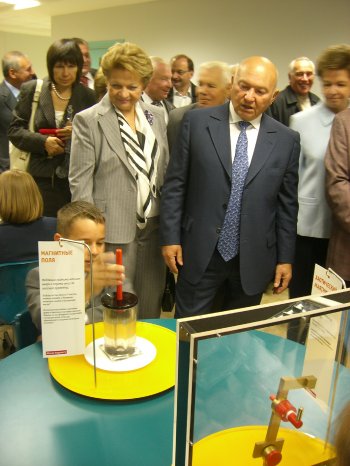Personal notebook computers are available for pupils in the school, and children can take them home. There is a publishing centre, a photo and film studio, a modern library, an Internet club and a medical centre. Starting with the eighth grade, professional training is provided for pupils for specialisation in some fields.
The schools combines formal and “free-choice learning” by providing special spaces for the children with various interactive exhibits, which can usually be found in children's museums and science centres, such as a large water play area with fountains, locks and dams.
The overall basic idea of the school is, on the one hand, to make the traditional ex-cathedra teaching method more effective using modern equipment and technology. On the other hand the schools provides the opportunity to “play with science” in the breaks.
The theoretical and conceptual approach is provided by George E. Hein. With his treatise “Learning in the Museum”, George E. Hein has written a standard work, in which he appeals to the designers of exhibitions: Create a “constructivist exhibition”. His theoretical approach is modelled in a simplified form on the diverse theories of (Neo)constructivism in literature and social sciences and is really very helpful and quite fascinating. Visitors should not experience knowledge as something strange, but construct it in their heads themselves.
For us as exhibition designers this means that the exhibition must become a laboratory, in which there virtually are no prefabricated results which the visitors are served. Bearing this concept in mind the exhibits and installations for the school are designed to motivate students in WANTING to understand and learn. The fact that students are taken seriously and that they have understood or can understand something will make it easier for the teachers to perform their lessons more effectively.
The interactive exhibits were designed and build by Hüttinger and Ian Russell form the UK.
Hüttinger, established as an engineering firm in 1921, is a one-stop shop for exhibition planning, design and fabrication. We develop environments that promote exploration and understanding through multi-sensory experience.
As a multi-disciplinary firm we can provide full-range design, communications and production services to museums, corporations and themed attractions around the globe. Our services include: Feasibility study, master planning, programme development, scientific research, conceptual design, interactive media design, architectural and interior design, design development and specifications, project management and exhibit fabrication.
Our preferred method of working is with a design/build approach. This, together with a large in-house capacity allows us to plan and deliver turnkey solutions within a single project cycle, resulting in time savings, cost savings and, ultimately, a far more satisfactory final exhibition. The essential prototyping is integral with the whole process. All in all, our clients get the best value for their money. Where design/build is not an option, we are happy to work as designers, and to bid separately for the fabrication contract.
Current key clients include:
2001 Glasgow Science Centre, Floor 1
2001 Dubai Children's City
2002 Ruhr Zoo Gelsenkirchen
2002 Science South, South Carolina (current)
2003 Experience World “Gläserne Werft”, Bremen
2003 Phaeno Science Center (on-going), Wolfsburg
2003 Odysseum Cologne (on-going)
2004 Prince Salman Science Oasis, Riyadh
2005 Guangdong Science Center
2006 Technopolis Mechelen
2006 Communications Museum Macau
2006 Artic Centre, Rovaniemi, Finland
2006 Science House, Europa-Park, Rust
2006 Science Museum London (on-going)
2007 National Science Museum Thailand
2007 Palais découverte Paris

